Table of contents
Getting Started with Ticket Director
Monday September 25, 2023-27 min readIntroduction
If your company handles a large volume of customer inquiries and technical issues, having an efficient ticket management system is crucial. While the Tickets app is designed to create and track your own inquiries, Ticket Director is designed to manage incoming tickets to your organization. This guide will cover how to add, view, edit and respond to tickets from your customers and internal employees.
Let’s get started
To open Ticket Director, go to the Operations category of the main navigation bar and select Ticket Director.
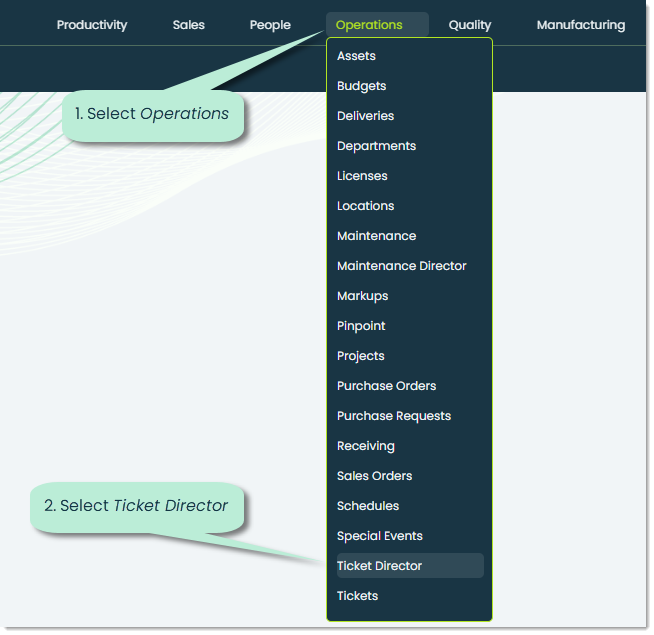
When you open the app, you’ll see a list of all your organization’s tickets in the All tickets tab.

Let’s go over each tab:
1. My tickets – This tab contains all open tickets for which you are the assigned agent. This means that you are responsible for managing and resolving these tickets. Tickets are sorted by priority level with the higher priority tickets showing up first.

2. All tickets – The app opens to this tab by default. It contains all of your organization’s open tickets.
3. Board view – This tab provides a Kanban visual of your organization’s open tickets. It serves to provide a helpful view of the ticket lifecycle.
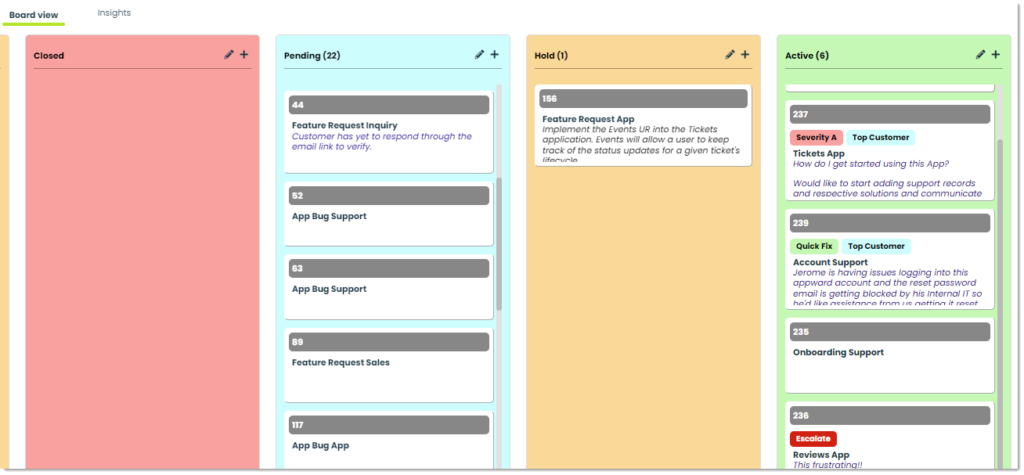
4. Insights – This tab is used to analyze ticket data. You can configure highly-customizable SQL queries for gaining valuable, measurable components of your tickets such as completion rate, average ticket duration or whatever other statistics you’d like to measure. For more on Insights, check out the Getting Started with Insights guide.
Let’s try adding a new ticket
Let’s go through the standard process of adding a ticket. To begin, click the + button at the top of the screen.
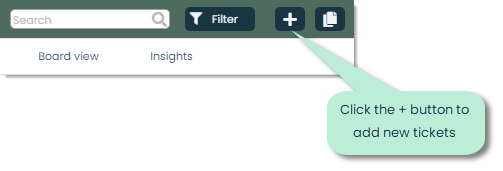
Step 1 – Select the contact of the person submitting the inquiry.
The first step is selecting the person that the ticket is being made for. You can either search through your existing contacts or create a new contact for that person. Let’s quickly go over both methods.
Search existing
To search for an existing contact, check the box next to Search existing.
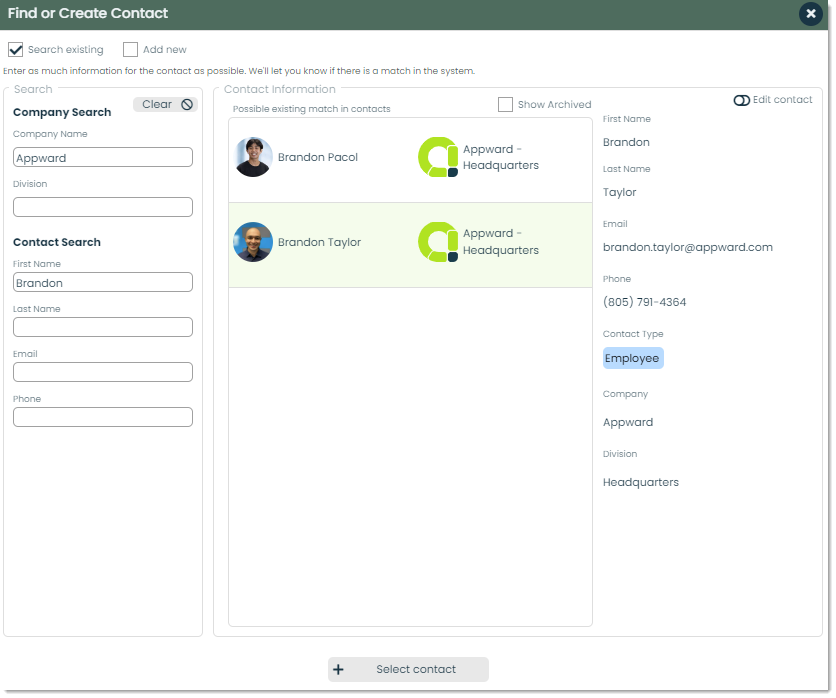
From this screen, you can use the search fields in the left section to find an existing contact. You can search by company or by contact information including name, email and phone number. As you input information for searching, any possible matches will populate the middle section. Optionally, you can check the box next to Show Archived to include any archived contacts in your search. If you see the correct contact come up, you can click on that contact and press + Select contact at the bottom to choose that person for the ticket.
Add new
If that person doesn’t exist as a contact, you can quickly add them by checking the Add new box and entering all the available information. From here, you can enter different pieces of information for that contact including their company, contact type, contact information, address and any additional information. For more information on selecting a company or contact type, please refer to https://www.appward.com/knowledgebase/selecting-a-company-with-the-company-picker/ and Selecting a Record Type.
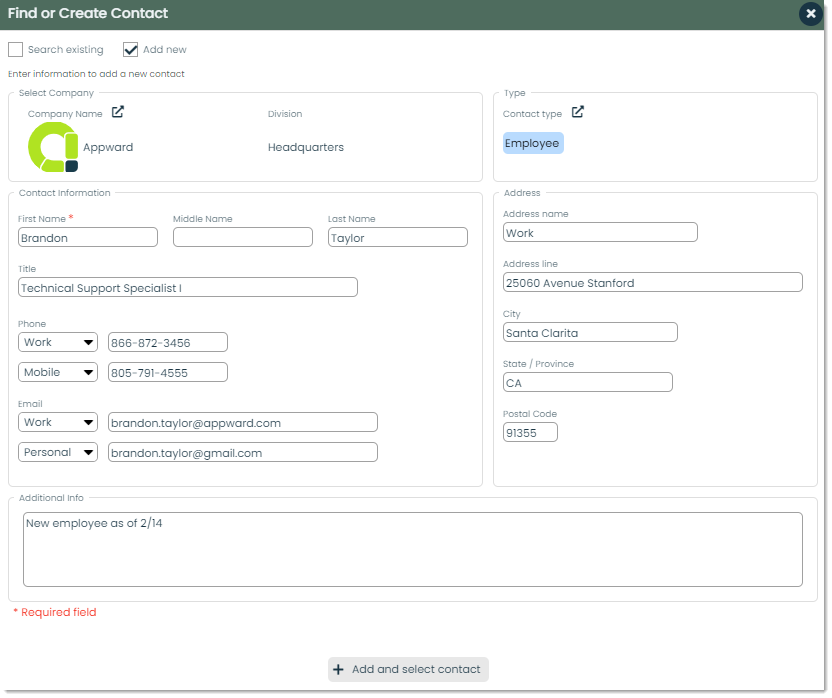
Once you have either found the existing contact or created a new one, click Select contact at the bottom of the popup to add them to the ticket.
Step 2 – Enter in the details of the ticket.
Once you’ve selected the appropriate contact of the ticket, the next page will prompt you to add some details of the ticket itself. Let’s go over the fields of this popup.
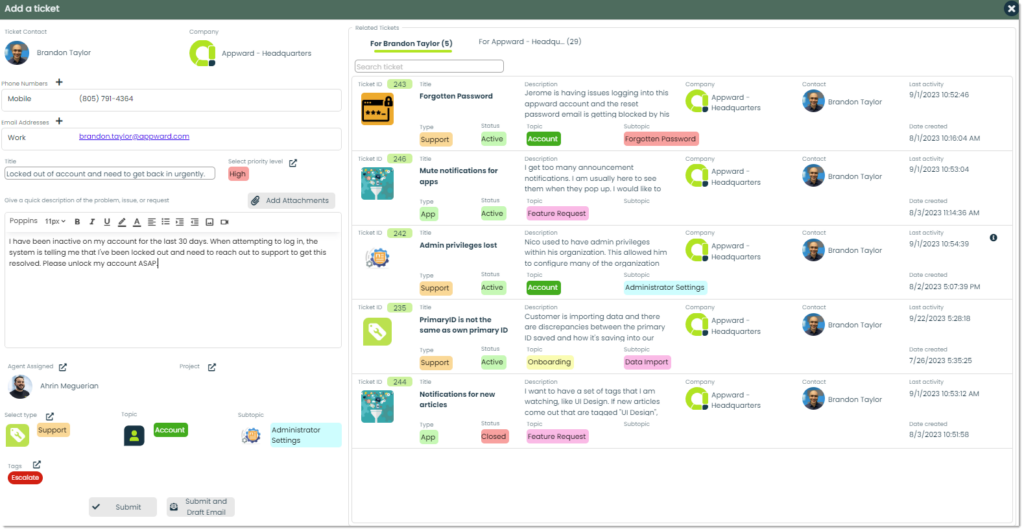
Ticket Contact – This is the contact chosen from step 1 of this section. It symbolizes the person who is sending the request in hopes for a resolution to an issue.

Company – This is the company of the ticket contact.

Phone Numbers – The phone numbers listed here come from phone numbers of the Ticket Contact. You can add in any amount of phone numbers here by clicking the + button next to Phone Numbers. Add in a name of the number such as Main or Mobile and the actual number.

Warning: Any numbers added to a Ticket Contact will be added to the ACTUAL CONTACT. This means that if you add a number to a Ticket Contact, then go into the Contacts app and pull up the same contact, you’ll see that the number has been added in both places.
Email Addresses – Similar to phone numbers, email address come from the email addresses of the Ticket Contact. You can add any amount of emails by clicking the + button next to Email Addresses. Add in a name of the email such as Work or Personal and the actual email.

Title – The title should provide a clear and concise description of what the ticket is about. It should help both the ticket creator and those responsible for handling the ticket quickly understand its purpose and content.

Priority level – Priority levels for support tickets help in categorizing and managing issues based on their urgency and impact on the customer or business. The specific priority levels used can vary from one organization to another, but some examples of priority levels can include High, Medium and Low. To choose a priority level, click the external link icon next to Select priority level and you can either choose from the list or add in whatever priority levels best suit your ticketing system.

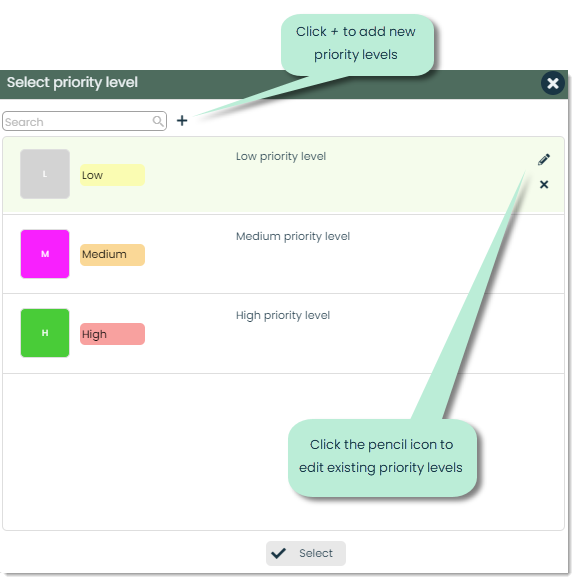
Description and attachments – The more information provided in the ticket description, the easier it will be to understand and address the issue efficiently. Clear and well-documented tickets help streamline the support process and lead to faster issue resolution. On top of that, attaching any important files is as easy as clicking Add Attachments. With this feature, you can add in any important documents from your computer or the Appward cloud.
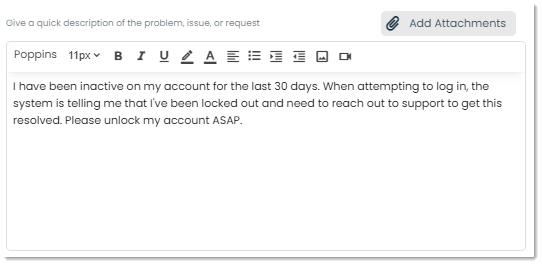
Agent assigned – The assigned agent is the person responsible for resolving the ticket. You can adjust this person by clicking the external link icon and selecting the appropriate person from your list of contacts.

Project – If the ticket is linked to a long-term project from the Projects app, you can identify that with this field.

Type, topic and subtopic – In Ticket Director, these three fields are closely intertwined.

Let’s define Type, Topic and Subtopic, then go over the process of making your selections.
- Type – Types are a method of classifying tickets into categories for better organization and searchability. Your ticket types will ultimately come down to what best suits your business. For example, at Appward, we have an App type which is for app-related issues and Billing for any inquiries about pricing.
- Topic – While the type is a broader classification of a record, the topic is a more specific categorization which begins to narrow down what a ticket is about. For example, where App can be seen as the type, a specific app name could be considered the topic such as Training or Contacts.
- Subtopic – When it comes to ticket management and coming up with the quickest, most accurate solutions, specificity is very important. If applicable, the subtopic is the most specific level of categorization you can assign a ticket. Where App is the type and Training is the topic, Testing/Evaluation can be seen as a subtopic where the central issue is something to do with assessments in Training.
Let’s go over the workflow of adding these three fields.
To begin, select a type by clicking the external link icon next to Select type. This will open a three-step popup which looks like this:

You can choose a type from the default list, edit any type by clicking the pencil icon on the right side or add in your own types by clicking the + button next to the search bar.
After you’ve made your selection, click Next to add in a Topic.

Topics that fall within the type you selected will appear as the options. Similar to types, you can choose from the list, edit any topic or add in new topics as you see fit.
After you’ve chosen the topic, click Next to add in a Subtopic.

Just like topics, subtopics will appear here based on the topic selected. From the listed options, you can choose one, edit the options or add in a new subtopic. After you’ve made all three selections, click the Select button at the bottom of the popup to confirm your choices.
Tags – Tags are similar to Types in that they are key terms used to group and organize tickets into different categories. This is great for searching for specific records. The main difference is that each ticket can have one type but multiple tags. Therefore, tags tend to be a little more narrow and particular.

Related Tickets – While this is not necessarily a field, the Related Tickets section acts as a guide for new tickets. When you go about adding a new ticket for a particular contact or company, you can view existing tickets to get an idea of potential solutions or methods of handling specific customers. Sometimes, the solution to a ticket may already exist. With this section, we eliminate the need for you to repeat what has already been solved.
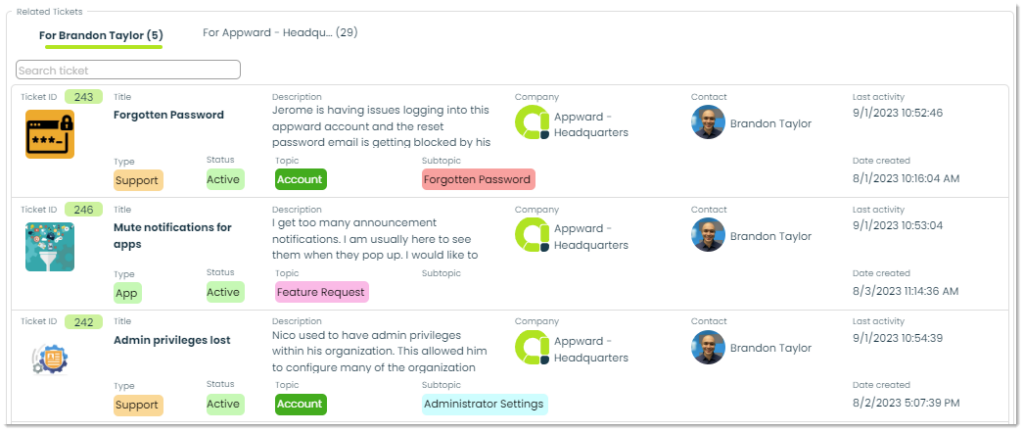
Once you have input all of the information of the ticket, you can either click Submit to simply create it or Submit and Draft Email to create the ticket and compose an email for the contact with a link to the ticket. Either way, the ticket will be created upon clicking your choice.
Let’s take a look at submitting a ticket with an email draft. After the submission of the ticket, a popup for composing an email will come up with a link to the ticket.
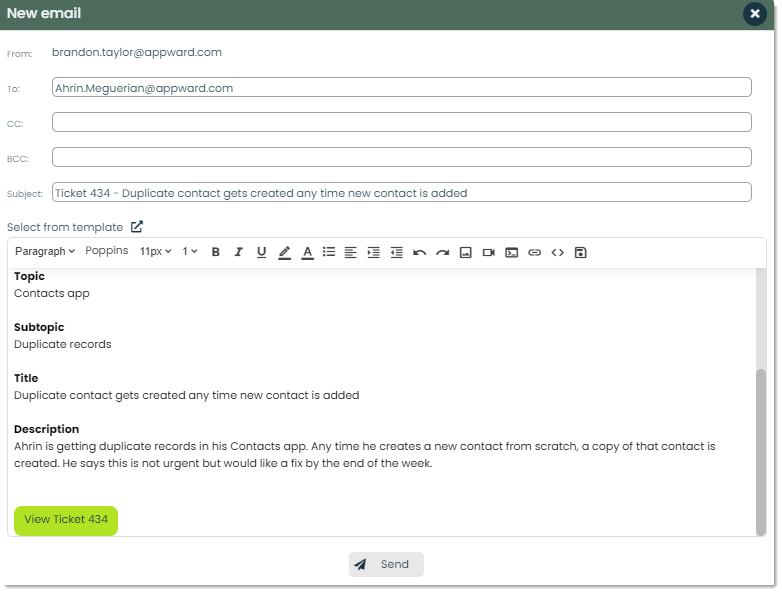
In order to send emails from a particular address, you must first authenticate yourself. This means that when you go to send an email from a specified address for the first time, a popup from your email provider will appear and you must sign in using the correct email and password. Once you have done that, you’re good to send to whoever you want.
Note: You must reauthenticate for any new device that you try to send an email from.
Optionally, you can use an email template to streamline your ticket processes even more. To do so, click the external link icon next to Select from template and a popup like the one below will appear.
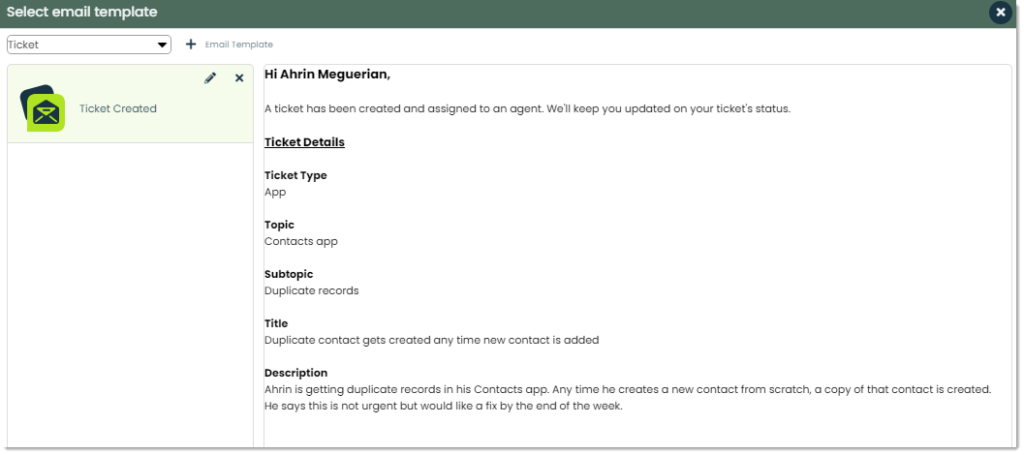
The above template will take all of the information from the created ticket and turn it into a nicely formatted email. Ticket Created is a default email template provided by Appward, but you can create your own templates by clicking + next to the top-left Email Template caption. For more on creating email templates, please read our article on Creating Email Templates.
Once you’ve composed your email and selected all the desired recipients, click Send to send that out.
Let’s open the details of a ticket
If you click on any ticket from My tickets, All tickets or Board view, you can view its details. Here’s what the Details tab of a ticket looks like.
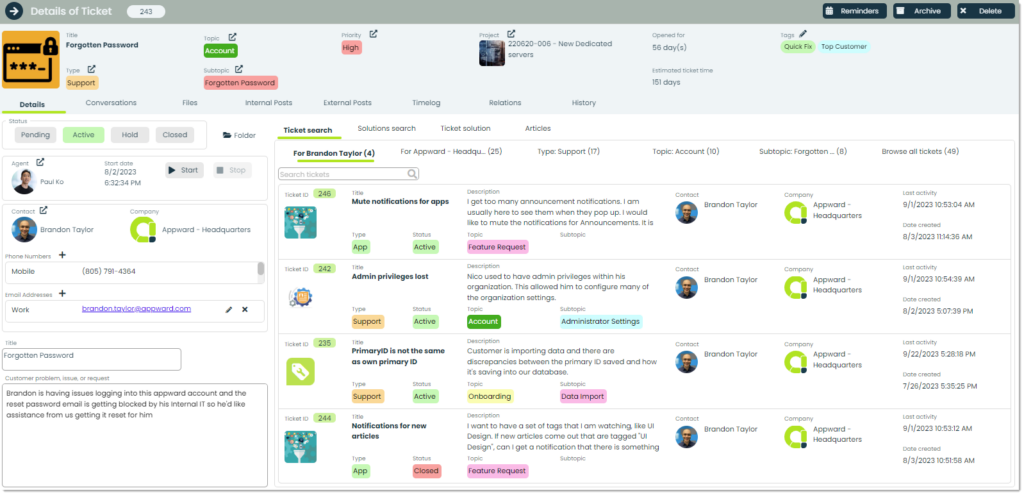
From here, you can edit any information that was input when the ticket was created. Let’s go through some of the additional features of this details screen.
Status – The possible statuses of a Ticket are Pending, Active, Hold and Closed. Here’s what each status means:
- Pending – The assigned agent has not started working on the ticket.
- Active – The ticket is currently being worked on.
- Hold – The ticket has been temporarily set aside until further notice.
- Closed – The ticket has been resolved. All closed tickets are automatically hidden from the main list.
By default, newly-created tickets will start off as Pending. As the assigned agent works on the ticket, they can adjust the status by clicking on the different status buttons.

Folder – If you need to access or add any important documents to a specific ticket, you can click on this button to open up the File Explorer to where the ticket resides and upload or download whatever you need.

Start and Stop – These buttons control the timing feature which tracks the total time spent on a ticket. When you click Start for the first time, the timer will begin and the Start date field will get populated with the current date and time. This will also change the status of the ticket from Pending to Active. When you click Stop, the timer stops. You can see a full log of time spent on any particular ticket with the Timelog tab.

Note: Stopping the timer does NOT affect the status of a ticket. It is simply used for timing purposes. To modify a status to Hold or Closed, you must click it from the status buttons.
Ticket search, Solution search, Ticket solution and Articles – This section is for researching and posting a solution to a given ticket. You can look through previous tickets, existing solutions and your organization’s articles for anything that might be helpful. Once a solution has been found, you can post it in the Ticket solution tab. We’ll go through the process of resolving a ticket in the next section.
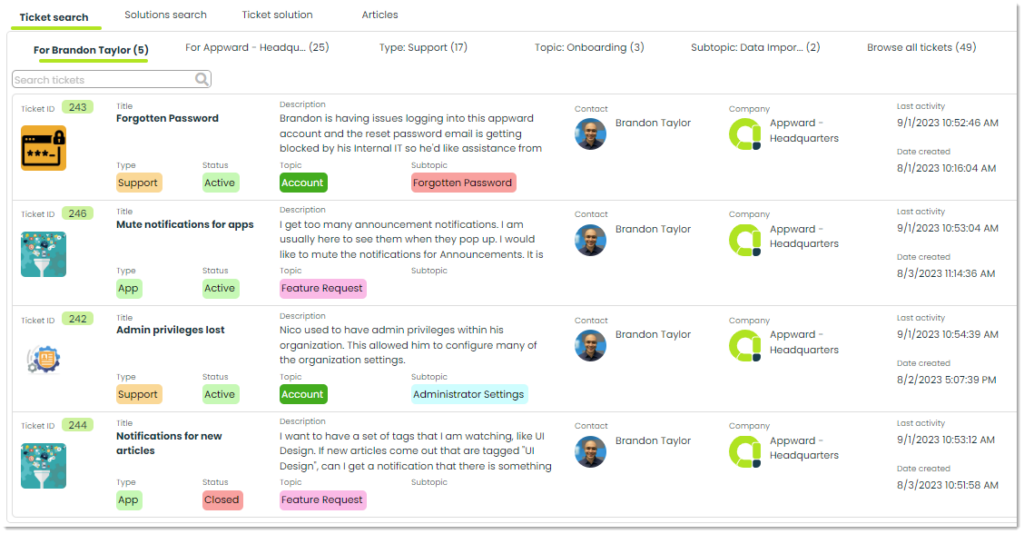
Let’s resolve a ticket
You’ve just been assigned as an agent to a ticket. Let’s go through the standard process of resolving it. Here are the steps:
- Open the ticket details
- Go through the information provided
- Start the timer
- Do your research
- Submit your solution
- Close the ticket
1. Open the ticket details
From My tickets, All tickets or Board view, click on the ticket record of your choice to access its details.
2. Go through the information provided by the contact and/or previous agents
Go through any conversations from the Conversations tab, files from the Files tab and posts from the Internal and External Posts tabs to get as much context of the inquiry as possible. The next section will cover these tabs in depth.
3. Start the timer
Once you are ready to take on the ticket, start the timer by clicking the Start button in the top-left corner of the Details tab. This will also make the ticket status Active. If you have to pause on a ticket, you can click the Stop button to pause the timer until you resume your work.
4. If necessary, do your research
This is where the right section of the Details tab comes in. There’s a lot going on here, so let’s go through each tab.
- Ticket search – With this tab, you can search through existing tickets to get an idea of how to handle certain problems. The inner tabs can be used to filter for tickets by the contact, the company that the contact belongs to, the ticket type, topic, or subtopic. You can also view all tickets with the Browse all tickets tab. You can click on any result to view a description of the ticket, any important files in the Files tab and, if applicable, the solution.
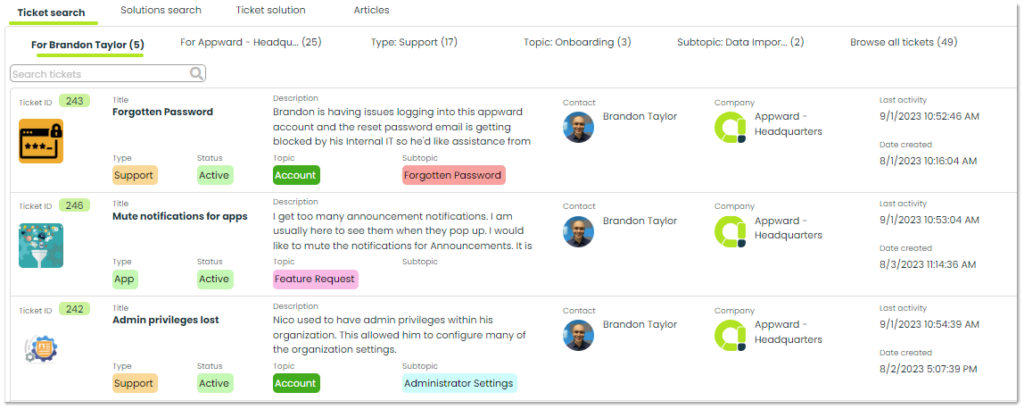
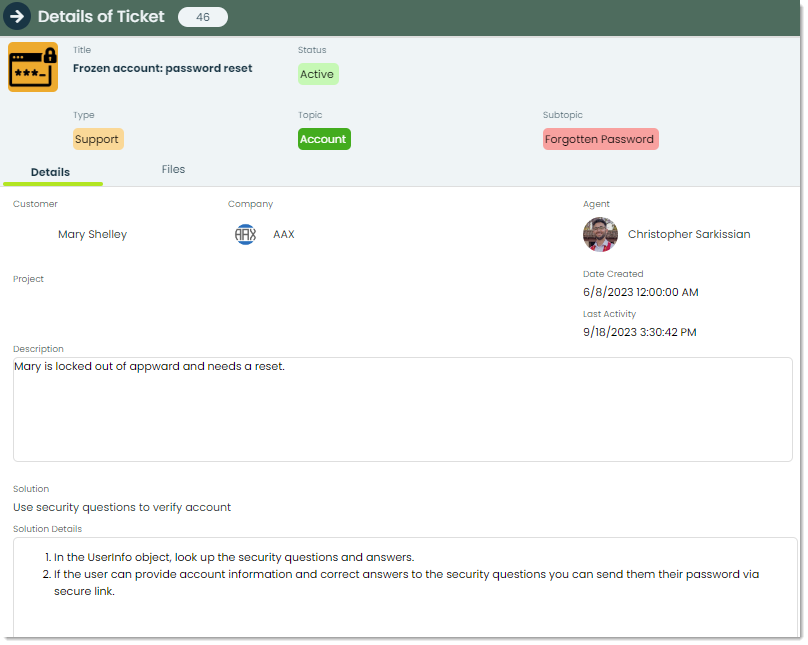
- Solutions search – This tab can be used to find a possible existing solution to the ticket. You can use the search filters at the top of the screen to find what you’re looking for. If the solution suits your ticket, you can click on it to open its details and use the Transfer solution to ticket button to transfer the solution to the Ticket solution tab and use it for your own!
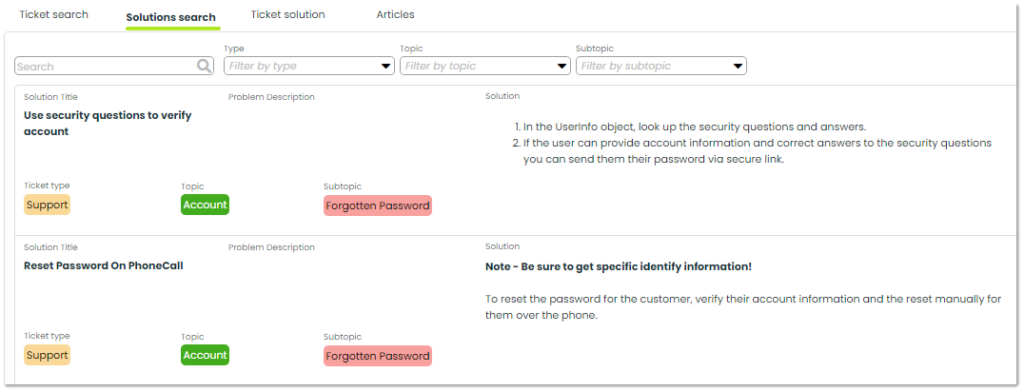
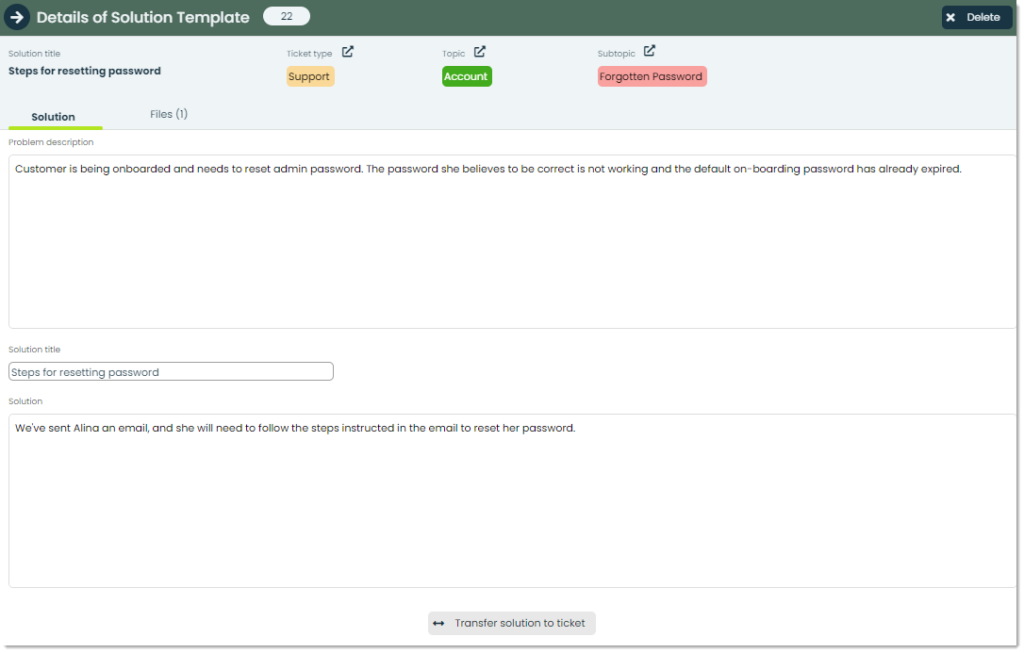
- Ticket solution – This is where you’d place the solution to your ticket. Give it a title, a description of how to solve the problem and you can save the solution as a template to have it accessible via the Solutions search tab.
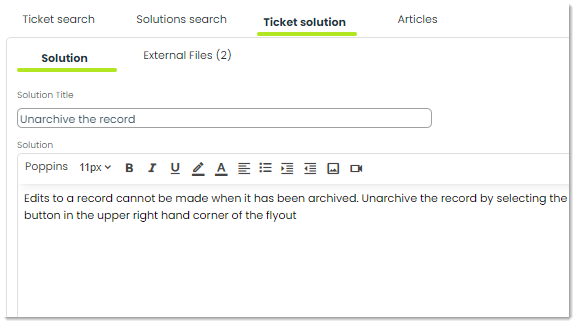
- Articles – This tab is used to search for and view your organization’s articles. You can search for any topic that may be helpful in solving the problem of the ticket and read up on the information.
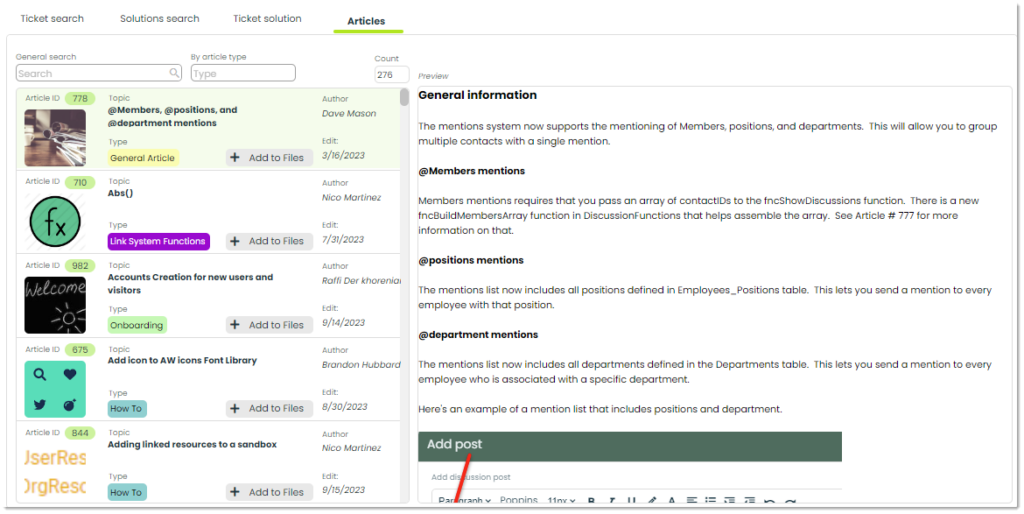
5. Submit your solution
Once you have come up with a solution in the Ticket solution tab, click the Send solution button in the bottom-right corner to send the solution to the contact.
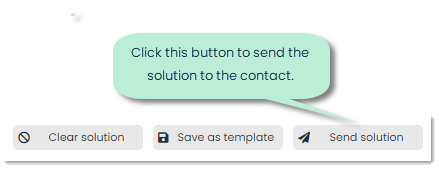
The contact will receive an email with the solution. If the contact is an internal employee with access to Tickets, they will also be able to see the solution in the details of the ticket by going to the Ticket solution tab.
6. If everything is solved, close the ticket
Once you’ve received confirmation from the customer that the ticket has been solved, it’s time to close the ticket. To do so, simply click the Closed status button. And just like that, you’ve solved your first ticket. Congrats! The next sections will cover the Conversations, Files, Internal Posts and External Posts tabs.
How to use Conversations
Communication over the course of solving a ticket is incredibly important. Ticket Director provides an intuitive way of sending and storing a log of conversations had with your ticket contacts through Conversations. This can be found in the Conversations tab of any ticket’s detail page.

Conversations are just as they sound. They are interactions had between a group of people. To add a new , click the Add conversation button found next to the search bar.
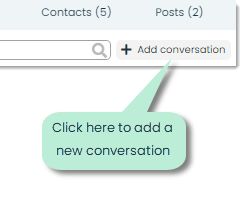
This will open a popup for a adding a new conversation to your ticket.
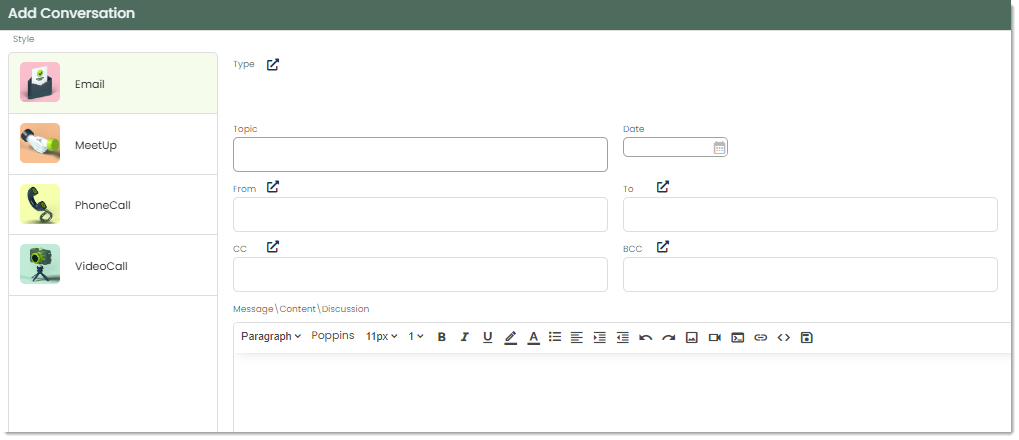
In Appward, conversations can be added in one of the four methods known as styles. The four conversation styles are email, meetup – a meeting of some sort, phone call and video call. Depending on the style of conversation, a slightly different set of fields will appear. For example, emails contain CC (carbon copy) and BCC (blind carbon copy) fields which are standard for any email service. Fill out all the information of your conversation, then press the Submit button at the bottom to add that to the list of conversation records.
Important: If you are adding an email conversation, you can send the email from Ticket Director! As long as you have provided authentication for the From email, you can add the conversation to your conversation thread AND send the email by clicking Send email & submit at the bottom.
For more on Conversations and how to use it, please refer to the Getting Started with Conversations guide.
How to use Files
Appward provides a method of storing important documents for any particular ticket with the Files tab. With this feature, you can add in any files to a ticket and view them with an embedded document viewer.
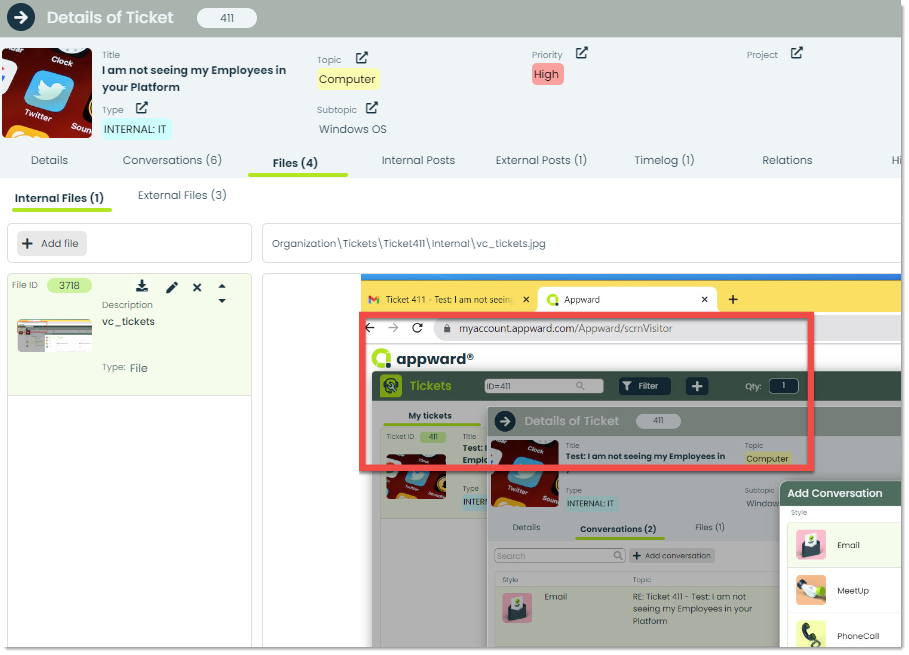
What makes the Files tab in Ticket Director different from other apps are the two file categories: Internal and external. Internal files are only visible to agents working on the ticket. External files are visible to the customer. Any files posted by the customer will appear in the External files tab.
To add a new file, choose either Internal Files or External Files and click Add file. From here, you can select a file from your computer, the Appward file explorer or from your database of articles.
How to use Posts
A post is a written comment which can be replied and reacted to by other people. In Ticket Director, there are internal and external posts. Internal posts are only visible to agents working on the ticket. You can write a post with any questions or comments for other agents and mention them with the @ symbol to quickly link them to the ticket. External posts are visible to the inquirer. This is where you’d see any posts sent from the person needing assistance.
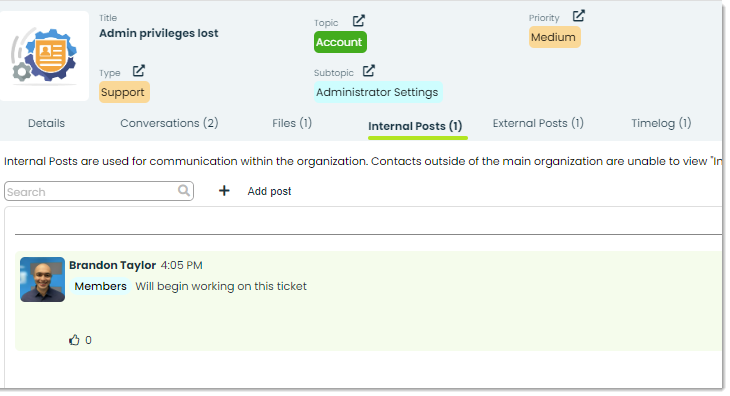
To add a new post, choose whether you’d like to add an internal or external post, then click the + Add post button and write out your message. Click Submit to send the post.
How to use the other Frontline Features of Ticket Director
Each app has a set of Frontline Features which are designed to enhance your Appward experience. For Ticket Director, these are indicated by the tab names in the details page of any ticket. They are:
- Timelog
- Relations
- History
Let’s briefly touch on each of these and how they are used in Ticket Director.
Timelog – As stated in a previous section, you can control the timer of your ticket progress with the Start and Stop buttons. The Timelog tab also provides this functionality and is where you can track the actual start and stop times and durations. Additionally, if there are any inconsistencies in the logged times, you can edit the durations and/or descriptions by clicking the pencil icon to the right side of any time.
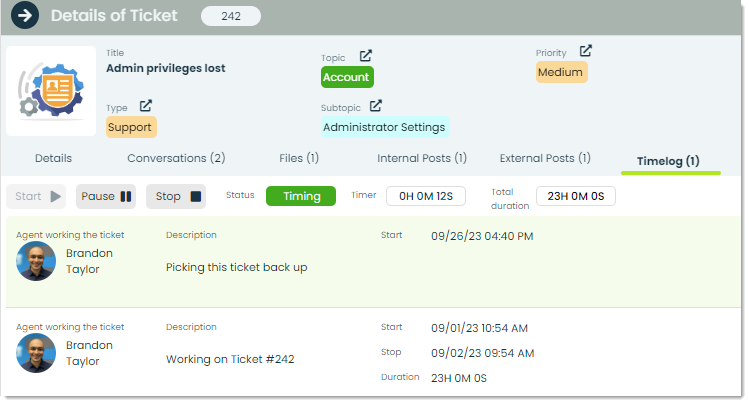
Relations – Relations are used to create a link between different pieces of data. Say, for example, a goal has been created in the Goals app for completing a certain number of tickets. If we wanted to link all completed ticket records to the goal for a centralized set of information, we can accomplish that through relations.
From the Relations tab, you can click the + button to form a new relation. You can indicate what kind of object the ticket is related to, identify the specific record and indicate the relationship between the two records.
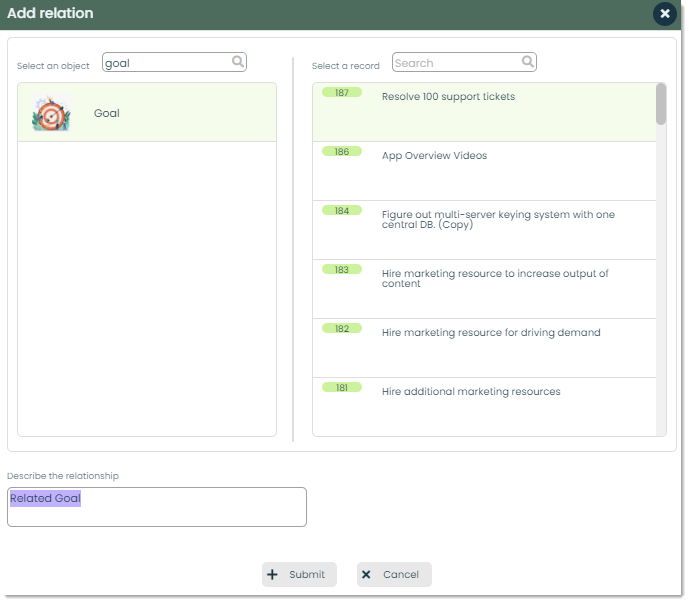
History – The History tab provides a detailed log of recent actions performed on a specific ticket record. This is useful for tracking who did what and at what time.
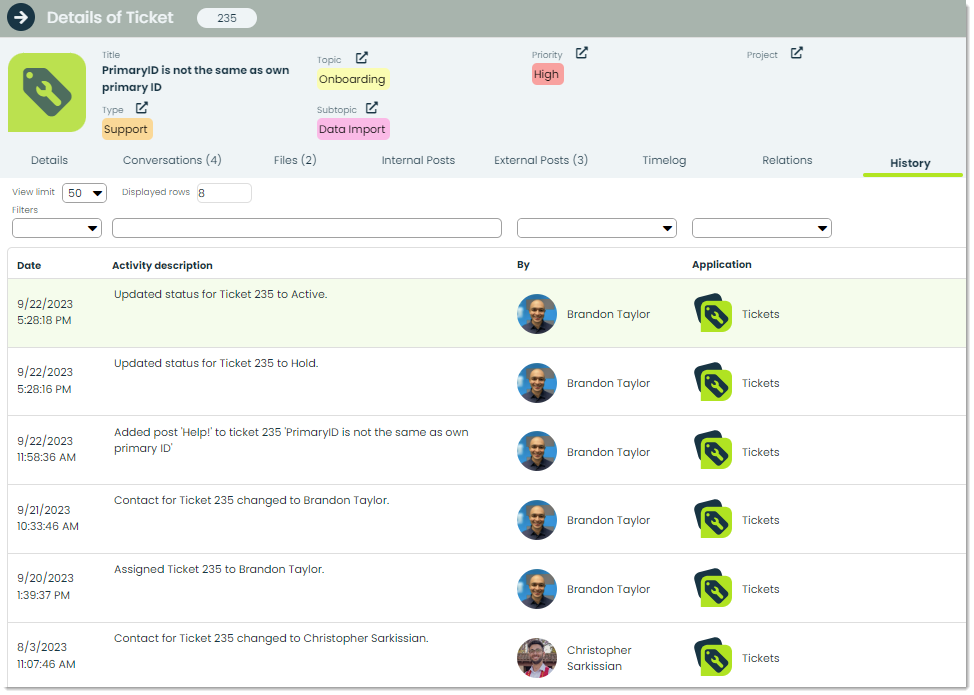
How to set a reminder, archive or delete a ticket
This section will go over three features that can be found in the top-right corner of the details page of all tickets. Those are setting reminders, archiving and deleting.

Let’s go through each of these buttons and how they work.
Reminders – Reminders are notifications set for a certain time to a specific person for a specific purpose. In the context of Ticket Director, reminders are important for ensuring that you are actively following up with tickets. Sometimes, progress on support tickets or inquiries can fall through the cracks, and reminders are a great way to make sure this doesn’t happen.
To view all active reminders for a given ticket, click the Reminders button.
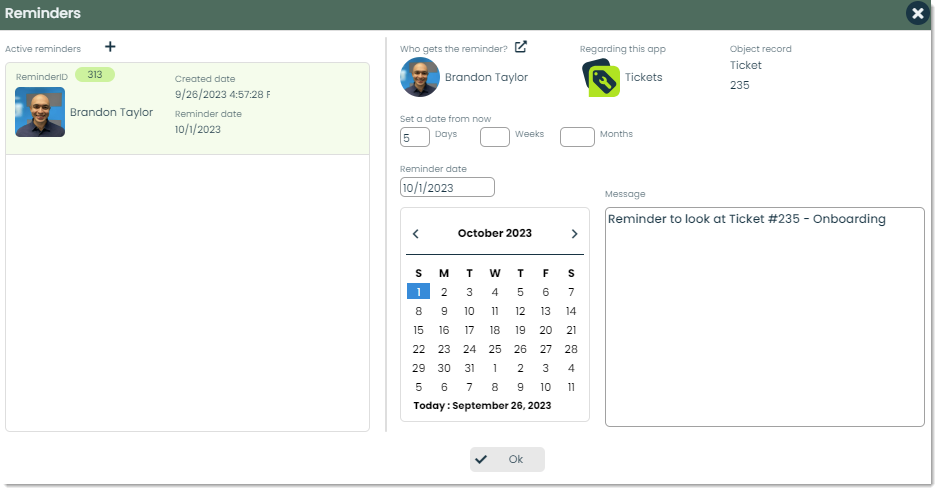
A list of all active reminders will appear on the left side. To add a new one, click the + button next to Active reminders.
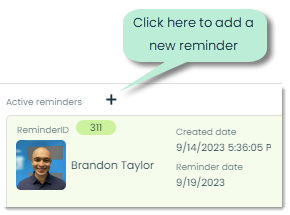
You can indicate who gets the reminder, when the reminder should go out and the message to be included in the reminder. When all desired information has been filled out, click Ok at the bottom to create the reminder.
Archive – Archiving is used to store records in a safe, accessible location other than the main list. It’s good for hiding records that don’t need to be seen.
Delete – To delete a ticket entirely, you can use this feature and the record will be removed.
